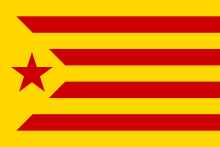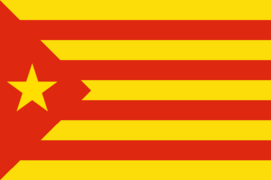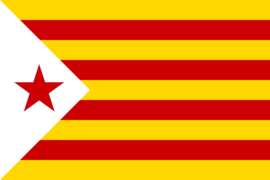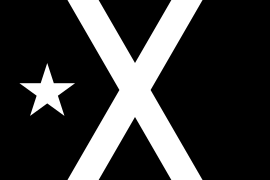Estelada
The estelada (in Spanish, "starred") is a flag used by citizens of Catalonia's independence ideology or by pan-Catalanist movements of the Valencian Community and the Balearic Islands. Its creator was Vicenç Albert Ballester, who was inspired by the Cuban and Puerto Rican flags for its creation.
History

Its origin dates from the beginning of the XX century and was born from the fusion of the four traditional bars on the Catalan flag with the starry triangle inspired by the flags of Cuba and Puerto Rico, after a stay in Cuba by Vicenç Albert Ballester, whose fight for independence from Spain he admired. In fact, Ballester was an activist of the Unión Catalanista party and of other Catalan independence movements and initiatives, and in his magazine La Tralla, for example, founded in 1903, Vicenç Albert Ballester used to sign VICIME (Viva la Independencia of Catalonia and death of Spain).
It is disputed what exact year Ballester created the estelada —for example, Enric Ucelay-Da Cal affirms that it was in 1917, while John H. Elliot says that it was in 1915—, but the truth is that the first Graphic testimony of the flag dates from September 11, 1918. It appears in a propaganda document of the Pro-Catalonia Committee written in English under the title What says Catalonia ('Qué dice Cataluña') that was addressed to the allied countries that won the First World War so that they deal with the "Catalan lawsuit" -curiously, in the Catalan version of the document the estelada was replaced by the sign. The next graphic proof of the estelada was a photograph that appeared in November in the newspaper L'Intransigent, of which Ballester was a collaborator, in which several young people appear carrying it in Montserrat along with the United States flag Joined. The following year some stamps were published with the estelada in the background and in which the phrase appeared: Societat de les Nacions-1919. Catalunya lliure.
However, there are some precedents for the estelada. The oldest is a stamp produced in 1904 by the Unió Catalanista, of which Ballester was a part, in which some of the elements of the estelada appear, such as the blue triangle and the white star.
For their part, Carles Llorens and Joan B. Culla affirm, although they do not give the exact date, that the first estelada waved at the Center Català in Santiago de Cuba, which was the first organized independence group born at the beginning of the century XX shortly after the island's emancipation from Spain, whose fight for independence had aroused great sympathy and support among Catalan emigrants in the island. However, according to Enric Ucelay-Da Cal, the flag designed by the Catalan community of Santiago de Cuba consisted of a blue rhombus with a white star inside that would go in the center of the senyera Catalan.
On the other hand, in 2008 the centenary of the estelada was celebrated, but the organizers of the commemorative event themselves acknowledged that they lacked evidence that the estelada had been designed by Ballester in 1908.
The estelada was adopted in 1919 as a flag by the pro-independence Federació Democràtica Nacionalista and by its successor Estat Català headed by Francesc Macià.
In 1928 the estelada was declared the official flag of the «Independent Catalan Republic» in the «Provisional Constitution of the Catalan Republic» that was written and signed in the capital of Cuba between August 15 and October 2 of that year during the celebration of the Constituent Assembly of Catalan Separatism chaired by Francesc Macià. Article 1 stated: «The official flag of the Catalan Republic is the historic one with the four red bars on a yellow background; with the addition, at the top, of a blue triangle with a white five-pointed star in the center".
During the Second Spanish Republic, the estelada was adopted by the youth of Esquerra Republicana de Catalunya and the Estat Català and Nosaltres Sols! parties, headed by Daniel Cardona. The members of this last formation defended themselves against the criticism of other Catalan nationalist groups for not using the sign, saying: “for us the star is the distinction that exists between the Catalans who bow down and betray and the Catalans who follow the unique path, rebellious and upright for the freedom of the homeland». During the proclamation of the Catalan State in 1934, the flag was raised in some town halls, and that was the intention of Josep Dencàs, to do so in the Ministry of the Interior, but President Lluís Companys forbade it.
During the Spanish Civil War, the estelada was the banner of the Macià-Companys column of the Popular Army, being prohibited during the Franco dictatorship. Some pro-independence groups such as the Front Nacional de Catalunya continued to use it in exile along with the flag and at the end of the 1960s the PSAN adopted it as its flag but changing its design. The white star was replaced with a red star and the blue of the triangle was changed to white for better visibility. In this way they wanted to show both the national and social commitment of the PSAN. Years later, the PSAN, to distinguish itself from the groups that had split from the party, changed the white triangle to a yellow one, following the model adopted in Perpignan in 1972 by the Esquerra Catalana dels Treballadors, since in France white was associated with the Bourbon monarchy. This is how the estelada vermella (the red estelada) was born, which was adopted from then on by the entire radical pro-independence left, including the terrorist organization Terra Lliure.
In the XXI century was when the estelada became popular at the same time that the independence movement grew in Catalonia, with the estelada predominating blue in front of the stellate vermella. In 2008 the green estelada appeared to vindicate environmentalism within the independence movement. Six years later, the Fundació Reeixida created a black estelada in commemoration of the third centenary of the "defeat of 1714".
Types
There are many kinds of Catalan esteladas, among them are:
- The so-called soft stall (“blue star”), which is the original and already found in 1918 publications. It is used by sectors of Catalan nationalism and non-Marxist ideology.
- The so-called I'll see you. (“red star”). The color of the star is red and is often related to the defense of an independent state of a socialist character. It was originally promoted by the National Socialist Partit (PSAN) in the 1970s.
- The so-called Estelada verda (“green star”). It is an independentist banner of peaceful struggle, which emerged in 2008 to also claim freedom for the Earth and nature, for an ecologist, animalist and humanist country. It was created in 2008, just on the centenary anniversary of the first appearance of the starry flag, 1908. The green triangle represents the land full of forests, green hills, animals where the heart looks the white star of freedom and peace. It is antimilitary and claims the right to decent housing, a country without tanks and bombs. The white star of the green stall not only represents freedom, but also peace.
- The so-called anarchist stall (“Anarchist star”) was used between 1970 and 1990 by anarchist sectors. The red of the star and the black of the triangle symbolize anarchism and the eight tips of the star represent each of the territories of the Catalan Countries.
The orientation of the star has not been fixed and sometimes it has a parallel side with the short edge of the flag and sometimes it has it with the long edge. Its dimensions have not been fixed either, but they are usually made two wide by three long.
Most frequent designs



















![Estelada con los colores del R. C. D. Espanyol[13]](https://upload.wikimedia.org/wikipedia/commons/thumb/d/d0/Estelada_RCD_Espanyol.svg/270px-Estelada_RCD_Espanyol.svg.png)
![Estelada con los colores del Club Joventut de Badalona[14]](https://upload.wikimedia.org/wikipedia/commons/thumb/8/8c/Estelada_Juventud_de_Badalona.svg/270px-Estelada_Juventud_de_Badalona.svg.png)
![Estelada con los colores del Palamós C. F.[15]](https://upload.wikimedia.org/wikipedia/commons/thumb/9/98/Estelada_Palam%C3%B3s_CF.svg/270px-Estelada_Palam%C3%B3s_CF.svg.png)